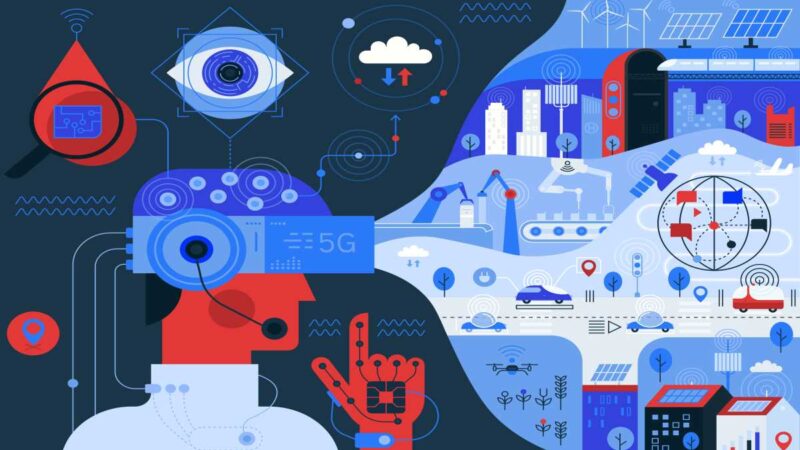
Why are we already talking about 6G?
Many ports are adopting 5G technology, as its advantages over 4G are clear. However, 6G is beginning to emerge in the technological discourse. This article explores why 6G is starting to gain attention, what it entails, and what possibilities it may offer.

Chiara Saragani is a researcher at CENIT and PhD student in digitalization at the Port of Barcelona.

The Evolution from 4G to Future 6G
4G connectivity was introduced in the late 2000s, marking a milestone in the evolution of telecommunications by offering higher data transmission speeds, enabling smooth access to video content, and significantly improving mobile web browsing.
In recent years, the deployment of 5G has begun to further transform the digital landscape. It not only provides much higher speeds than 4G, but also significantly reduced latency and a much greater connection capacity. This new generation of network has enabled the development of advanced applications such as autonomous vehicles, smart city sensor networks, and industrial process automation.
However, even as 5G is still expanding, 6G has already entered the research phase. The first implementations are expected to arrive in the 2030s, aiming to elevate current capabilities to a new level. This future technology will not only enhance technical performance but will also natively integrate Artificial Intelligence (AI), Machine Learning (ML), and quantum communications—opening the door to revolutionary breakthroughs like real-time holography and digital twins.
Differences Between 4G, 5G, and 6G
While the deployment of 5G has already impressed with its technical achievements, 6G is expected to be a true turning point. As with previous generations, the key parameters remain:
- Speed
- Latency
- Capacity
- Reliability
- Energy efficiency
However, the leap forward will be monumental: 6G is expected to reach speeds measured in terabits per second, compared to the gigabits of 5G and the megabits of 4G.
- With 4G, common applications focused on video streaming, email, and large file downloads, reaching speeds of up to 100 Mbps.
- 5G introduced gigabit-level speeds, enabling 8K video streaming and immersive virtual and augmented reality experiences.
- 6G will bring a major shift by managing much higher volumes of data, making it ideal for cloud storage environments, enterprise servers, and even more data-demanding services.
Speed is closely tied to latency—the time it takes for a device to communicate with the network—and here 6G sets another milestone: it is expected to transmit up to one terabyte of data with latency as low as one microsecond. This capability will enable seamless communication between humans and machines, opening the door to advanced applications such as autonomous vehicles, industrial automation, or remote surgery.
Another technical breakthrough of 6G is its use of extremely high frequencies in the terahertz (THz) range, compared to the roughly 100 GHz used by 5G. These higher frequencies allow for faster speeds and greater data transmission but also present additional challenges, as they are more vulnerable to interference. Therefore, evaluating and managing signal reliability will be a crucial part of 6G development.
Together, these advancements will significantly increase the capacity of 6G networks compared to current standards, enabling new types of services and highly demanding technological applications.
The Vision for 6G: Sustainability, Intelligence, and Connectivity
Beyond the technical aspects of the new 6G network—which are still difficult to fully imagine, especially considering that the deployment of 5G has only just begun—there are three fundamental features of 6G that deserve special attention:
- First, 6G is not only designed to connect an unprecedented number of devices but also to reduce its environmental impact compared to current networks. In fact, sustainability is one of the key pillars of 6G development. Some strategies proposed in recent research include advanced energy management techniques, dynamic energy harvesting systems, and energy-aware network designs and protocols. Energy management aims to reduce consumption through clean and renewable sources, as well as intelligent algorithms that detect opportunities for saving. Energy harvesting technologies could eventually enable 6G systems to operate autonomously, without depending on traditional electricity supplies. In terms of energy-efficient network design, the goal is to create optimized topologies that minimize energy usage across all system components.
- Second, integrated artificial intelligence will play a central role in 6G. AI algorithms will be embedded directly into the network, particularly in the radio access layer, transforming it into an "intelligent" network. This innovation will improve data transmission efficiency and provide the network with self-optimizing, self-repairing, and autonomous management capabilities. The result will be a much more reliable, efficient, and resilient communication system.
- Finally, 6G will help create a more connected world. Its integration with Internet of Things (IoT) sensors will enable advanced applications such as autonomous vehicles, remote health monitoring, and industrial automation. Smart homes, powered by an extensive network of interconnected sensors, will become a reality, with functions that we can barely imagine today.
Can 6G Be Useful for Ports?
Some ports around the world are already implementing 5G networks, but 6G promises to deliver solutions that would be very difficult to achieve with current systems. Beyond isolated use cases, the real innovation lies in the ability to apply these technologies at a much larger scale.
- Real-time cargo tracking: 6G will enable real-time tracking of cargo containers through IoT sensors, improving inventory management, reducing losses, and increasing efficiency in loading and unloading operations.
- Autonomous vehicles and equipment: Ports will be able to deploy autonomous vehicles and equipment — such as cranes and automated trucks — that will operate seamlessly thanks to 6G connectivity. This will enhance safety, reduce human error, and optimize workflows.
- Enhanced security: With integrated artificial intelligence, 6G can reinforce port security measures by enabling real-time surveillance, threat detection, and automated response systems, ensuring a safer environment for both workers and cargo.
- Smart infrastructure: 6G will support the development of intelligent port infrastructure, such as automated lighting systems, energy management, and predictive maintenance. This will result in cost savings and greater sustainability.
- Improved communication: 6G will facilitate better communication among all port stakeholders, including shipping companies, logistics providers, and customs authorities. This will streamline processes and reduce waiting times.
- Advanced video analytics: 6G’s ultra-fast connectivity will enable seamless intercommunication between sensors and cameras to monitor and analyze port activities. Cameras will be able to identify different types of entities, improving both safety and operational efficiency. Additionally, by processing large volumes of video data rapidly, 6G will help detect potential threats, optimize cargo handling, and enhance traffic management.
In summary, 6G not only promises greater speed and efficiency but has the potential to transform ports into fully intelligent, automated, and sustainable ecosystems.

The Main Challenges of 6G Connectivity
Although the development timeline for 6G is shorter than that of previous generations of mobile connectivity, there are still significant barriers that must be overcome in the coming years to ensure its successful deployment.
An article by Telcoma Globaloutlines several key challenges in 6G development, which can be summarized as follows:
- First, there is the issue of spectrum allocation. To support the high frequencies required for 6G, sufficient spectral resources are needed.
- Second, it is necessary to advance research to define the specific hardware and infrastructure that will be able to sustain these connections. Although 6G is expected to optimize energy allocation, there is still much to resolve about how to manage the enormous data traffic that this technology is expected to generate.
In addition to these technical challenges, 6G networks will need to address issues related to security and privacy. With the growing number of connected devices and critical applications, advanced methods of encryption, authentication, and intrusion detection will be essential to protect against cyber threats. Achieving global standardization and ensuring interoperability will be crucial for the mass adoption of 6G, which will require close collaboration between industry stakeholders, regulatory bodies, and standardization entities.
Ethical and social concerns must also be addressed, such as data privacy, algorithmic bias, and potential job displacement. The high cost of infrastructure development represents another significant barrier to the deployment and accessibility of 6G. Governments will need to establish regulatory frameworks that govern spectrum use, privacy issues, and public interests. Likewise, it will be necessary to develop new materials and devices capable of operating at terahertz (THz) frequencies and under extreme conditions.
Since 6G will rely on heterogeneous networks that combine cellular, Wi-Fi, and satellite systems, its management will add an additional layer of complexity. Finally, since there is currently no unified standard for 6G, both its development and implementation will require considerable time.
Even with all these challenges on the table, it is estimated that the development of 6G will require approximately half the time that was needed for the deployment of 3G.
Current Status of 6G Projects
Currently, no individual or organization has access to 6G connections, and the first tangible results of this technology are expected to emerge around the year 2030. However, multiple initiatives are already underway focusing on the development and exploration of 6G’s potential.
One of the most prominent projects is SUSTAIN-6G, which aims to combine 6G connectivity with sustainability goals in the environmental, social, and economic domains. This initiative not only focuses on implementing new use cases, but also on establishing a roadmap for regulatory policies and standardization processes that ensure a responsible and sustainable deployment of 6G.
Another key initiative is 6G-VERSUS, which seeks to push 6G technology to its limits through a series of tests and six pilot projects across Europe. These trials are designed to address and evaluate the major challenges facing next-generation industries, especially those focused on sustainability and environmental awareness.
Outside Europe, China began its 6G research in 2018 and continues to make progress with companies such as Huawei and ZTE. According to its website, Huawei controls 32.8% of the global communication equipment market. In the United States, the Next G Alliance, formed in 2020, brings together major tech players such as Apple, AT&T, and Google. This alliance has identified 47 key technological areas to explore in order to fully harness the potential of 6G.
Meanwhile, according to Technology Magazine, South Korea has invested $11.7 billion in the development of its digital economy, including 6G-based services. Similarly, Japan has allocated $9.6 billion to a national strategy focused on the future of digital services, with 6G as one of its central pillars.
The transition from 4G to 6G represents a substantial leap in connectivity, speed, and technological capabilities. While 4G and 5G have already transformed industries and everyday life by enabling faster data speeds, lower latency, and greater capacity, 6G is expected to take these advancements even further. Its rollout is projected for the 2030s, with the standardization process already underway and the first specifications anticipated by 2028. Many countries have begun developing plans for their future 6G infrastructure.
The path toward 6G implementation will require close collaboration among industry stakeholders, regulatory bodies, and research institutions to address both technical and regulatory challenges



